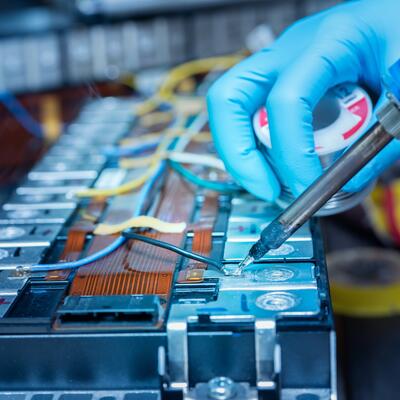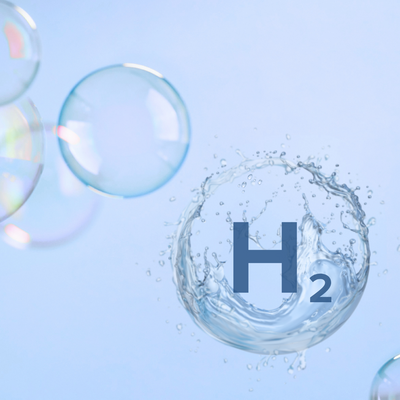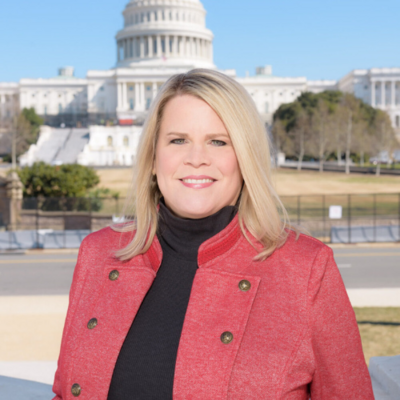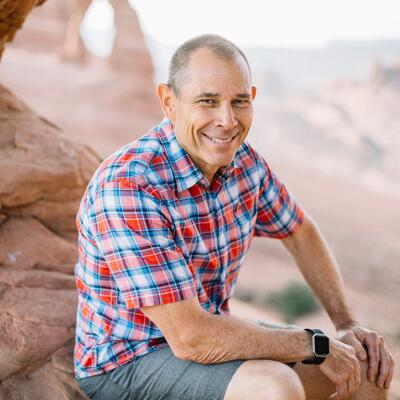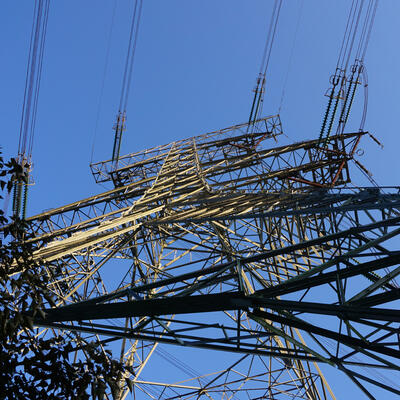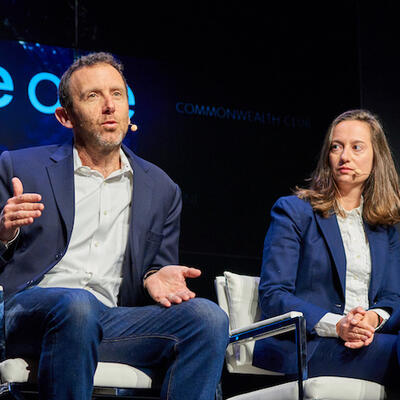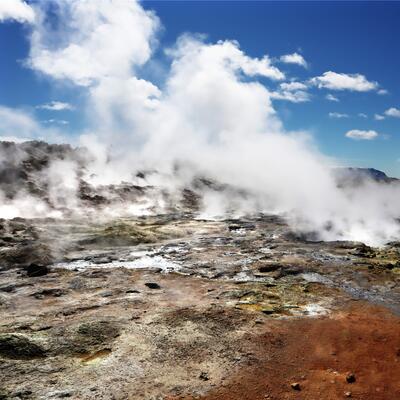
Geothermal: So Hot Right Now
Guests
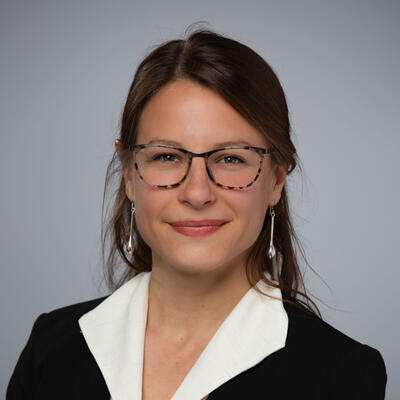
Amanda Kolker
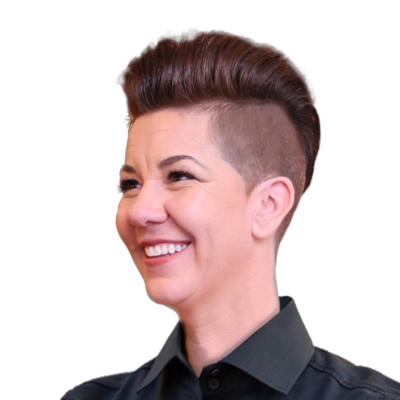
Jamie Beard

Lauren McLean
Summary
When most people hear the phrase renewable energy, they imagine fields full of solar panels or giant spinning wind turbines. But another source is heating up: geothermal.
According to Amanda Kolker, Laboratory Program Manager for Geoscience and Geothermal Technologies at the National Renewable Energy Laboratory (NREL), geothermal energy has been used for a long time. “The first generation, the conventional kind of older technology, started in 1906,” she says.
Most forms of electricity generation require the turning of a turbine, often by using steam. Geothermal is no different. Traditional geothermal energy production, as Kolker explains, “requires drilling a well in a place where steam exists in the subsurface at relatively shallow depths, and then this steam is channeled to a turbine generator where it pushes a series of blades mounted on a rotor shaft. And then the force of that steam on the blades spins the rotor shaft to the generator, which in turn converts that energy into electrical energy.”
“Everywhere in the world, below the surface, geothermal exists. Everywhere. The question is only, how deep is it?” says Jamie Beard, founder of Project InnerSpace. In a bit of a twist, technological advances made by the oil and gas industry might have unlocked the ability to build scalable geothermal energy, just about anywhere. Kolker says, “We're actually in an exciting period because I think we're undergoing a new revolution in geothermal power technology.”
Because the technology used in these new geothermal systems originates in the oil and gas industry, it offers workers in the fossil fuel sector a way to work in the clean energy space without having to completely be retrained. “Everybody feels and sees a way that they can win in supporting geothermal climate groups, environmental groups, oil and gas groups. People see a path,” says Beard.
As with the other sources of clean energy, permitting is once again a hurdle to be overcome. “On federal land, you can develop an oil and gas project at lightning speed compared to geothermal. Geothermal projects can take 10 or more years to work through the permitting process on federal land, which kills projects,” says Beard. But geothermal power stations may be able to avoid the community pushback that goes on over solar farms and wind fields. Beard says, “These are not invasive projects; they're pretty cool once you have them installed. Would I have a 50 megawatt geothermal power plant on my property operating and connected to the grid? For sure.”
Generating electricity is not the only application people have been using the earth's heat for. Some use it directly for heating. In Boise, Idaho, geothermal heating has been used since the 1890s. Mayor Lauren McLean, says, “My office, like the entire city hall, is heated with geothermal heat. You've got all the pipes, it looks like a puzzle, with a whole bunch of hot water coming in and that hot water and those pumps heat the city hall building as well as just under a hundred buildings downtown.”
Episode Highlights
1:52 - Jamie Beard on her journey to geothermal energy
4:27 - Jamie Beard on what makes geothermal cool
8:41 - Amanda Kolker on how geothermal energy works
14:08 - Amanda Kolker on geothermal heat pumps
18:38 - Jamie Beard on what made her an environmentalist
27:12 - Jamie Beard on the surface impact of geothermal wells
41:38 - David Condos reports on geothermal energy testing in Utah
47:01 - Lauren McLean on geothermal heating in Boise, Idaho
Resources From This Episode (5)
Full Transcript
Note: Transcripts are generated using a combination of automated software and human transcribers and may contain errors. Please check the actual audio before quoting it.
Greg Dalton: This is Climate One. When it comes to clean energy, solar and wind tend to dominate the headlines, but another source may be heating up.
Amanda Kolker: Right now we're actually in an exciting period because I think we're undergoing a new generation, a new revolution in geothermal power technology.
Greg Dalton: Geothermal. We used to think that you could only harness the earth’s heat in very particular places, but that turns out not to be the case.
Jamie Beard: Everywhere in the world, below the surface, geothermal exists. Everywhere. The question is only, how deep is it?
Greg Dalton: And the key to unlocking that clean power comes from a surprising place: the fossil fuel industry.
Jamie Beard: What we need to do is a lot of technology transfer, learning transfer, and workforce transfer from oil and gas into geothermal.
Greg Dalton: Geothermal Energy: The Heat Beneath Your Feet. Up next on Climate One.
I'm Greg Dalton.
Ariana Brocious: I'm Arianna Brocious.
Greg Dalton: And this is Climate One.
Greg Dalton: When most people hear the phrase renewable energy, they imagine fields of solar panels or giant spinning wind turbines. But today we're talking about an often overlooked source of clean energy. It's underground: geothermal.
Ariana Brocious: So let's quickly start by unpacking what geothermal is.The word itself offers some big clues. Geo meaning earth and thermal meaning heat. So basically geothermal energy is derived from heat within the earth.
Greg Dalton: Right. Often in the form of steam. And if you go to a hot spring or see the geysers in Yellowstone, you can see it bubbling up right from the ground. In other cases, it's deep beneath the earth's subsurface.
Ariana Brocious: Later in the episode, we'll get into exactly how we turn that heat or steam into electricity and how some people are using it to heat homes and buildings. And I'll admit this was a new field for me and I found it fascinating, particularly to learn how long we've been using geothermal energy.
Greg Dalton: And pretty widely too, geothermal is a bigger deal than many people realize. In California, it generates around 5 percent of the state's electricity. But I thought of steam as old school technology, choo choo trains. As I learned researching this episode, the technology has advanced.
Ariana Brocious: Right, and one of the more surprising twists in the climate space is that a lot of the technological advances that have helped geothermal improve and innovate have come from the oil and gas sector and fracking. Which is a contentious form of energy extraction and also a contributor to greenhouse gas emissions.
Greg Dalton: Right, and it's also made the U. S. a leading energy exporter. It's complicated. Jamie Beard is founder of Project Innerspace. Her organization is trying to get people in the oil and gas industry to turn their knowledge and skills to geothermal.
She made a similar pivot herself almost two decades ago.
Jamie Beard: I was at a startup company, an MIT spinoff that was working on high temperature energy storage. And it turns out there's a lot of applications for that sort of thing, defense and space and all these cool things. And one of the applications was oil and gas drilling. And so I found myself suddenly, as a startup founder thrust into the world of oil and gas, and you know, I had been an environmentalist all my life, so that was a weird experience at first, but it was right at the beginning of the shale boom, when there were all sorts of really cool, innovative things happening in the field. And around that same time, there was a report published. And it also came out of MIT called the future of geothermal energy. And this report laid out a really big vision for what geothermal could be for the world, really big. Like, you know, it could solve all of our energy needs many thousands of times over, but it's you know, it's just a set of engineering challenges. And for me, it was this kind of eureka moment where you had me watching oil and gas in the field innovating through the shale boom, solving engineering challenges in real time, and then reading this report saying, wow, if we only knew how to solve really tough drilling challenges, we could solve energy. And it was just like, bam, I got to move to Texas.
Greg Dalton: Right,
Jamie Beard: So that’s how I got into geothermal.
Greg Dalton: That's interesting because you say you were an environmentalist. A lot of environmentalists hear about the shale boom as this terrible thing that made America the world's biggest oil supplier. And you're talking about it as this exciting technological innovation that related to this other cleaner energy source, geothermal that we're talking about today, that’s an interesting contrast.
Jamie Beard: Yeah, and you know, it wasn't, It did not happen overnight. This was a process for me psychologically, frankly, to make the jump, um, from oil and gas as villain to oil and gas as massive opportunity in terms of mitigating climate change.
Greg Dalton: And 15 years ago, the consensus among energy people I talked to was that geothermal works well, but it's kind of geographically limited to maybe 10 percent of places on land. How has your understanding of that changed where we can get geothermal?
Jamie Beard: Yeah, so this is the really cool part about geothermal. And I think this is what the world doesn't yet know, but really urgently needs to hear. So right now in, in the world, geothermal exists where it's really close to the surface. So most of the time, if you think about geothermal, you think about that hot spring you sat in on vacation, likely in Iceland or something, right? Something, something like that
Greg Dalton: or Old faithful. And Yellowstone. Yeah.
Jamie Beard: These, these dramatic surface manifestations of what we call geothermal energy, which by the way, is derived by this massive molten ball of energy in the center of the earth, right? And that happens to be the temperature of the surface of the sun. So it's a massive source of energy. And we see in some places in the world surface manifestations of that massive ball of energy. And those are erupting volcanoes and geysers and things, right? And so in the world right now, we have geothermal energy in places where it's literally bubbling up to the surface and we can see it there. But everywhere in the world, below the surface, geothermal exists. Everywhere. The question is only, how deep is it? You know, and in some places it's not very deep at all, it's really easy to get to, in other places it's deeper, but it's always there, everywhere in the world. And I think that is the opportunity that makes geothermal really promising and really massive, because that means that we don't need to go to the windiest places, we don't need to go to the sunniest places, we don't need to go to the places in the world where there's oil and gas, right? Geothermal can be produced. You could drill for and produce geothermal feasibly anywhere in the world where there's demand. So that means geothermal could be relevant near the biggest population centers in the world. And that's something that is totally overlooked, but massive opportunity in terms of growth and clean energy. And so the, you know, the way that I look at it, Greg, is like this. If you think of the way the world developed oil and gas over the last century, we didn't start with deep water oil and gas platforms offshore, right? We started with oil and gas laying on the ground in puddles, right? And, and someone walked up and said, look, there's oil and we burned it.
Greg Dalton: We've all seen that the Beverly Hillbillies bubbling up in the backyard. So,
Jamie Beard: And then the spindle top and the, you know, and all this. So this was, 100 year long process of realizing something was laying on the ground, drilling for it. And now we drill billion dollar ultra deep water, incredibly complex oil and gas wells.
Greg Dalton: So that gets to the question I have of costs, you saying geothermal power generation can be nearly anywhere. It's a matter of depth, which raises the question of, okay, deeper cost more.
Jamie Beard: Yeah, well that's true. And so if we go back to that analogy of it took us 100 years to get to offshore drilling, what does that mean for geothermal? Well, the way I look at it is this: Right now it's laying on the surface just like oil and gas was 100 years ago. And we're drilling for it in those places like in Iceland. But we don't have to reproduce the last hundred years of technology development that it'll take to drill for geothermal, even in deep places. What we need to do is a lot of technology transfer, learning transfer, and workforce transfer from oil and gas into geothermal. And therefore we can make technological leaps and save a whole lot of time developing those technologies.
Greg Dalton: We’ll hear the rest of my conversation with Jamie Beard later in the show. But I want to step back and talk through all the different ways to use the heat that’s naturally underground.
Ariana Brocious: I talked about this with Amanda Kolker of the National Renewable Energy Lab. She explained that there are two basic flavors of geothermal energy: It can be used directly to heat buildings. Or the heat can be used to make electricity.
Amanda Kolker: The first generation, the conventional kind of older technology, started in 1906. very mature technology, but it requires drilling a well in a place where steam exists in the subsurface at relatively shallow depths, and then this steam is channeled to a turbine generator where it pushes a series of blades mounted on a rotor shaft, and then the force of that steam on the blades spins the rotor shaft to the generator, which in turn converts that energy into electrical energy.
Ariana Brocious: This Is how we generate a lot of our electricity: Whether it’s a coal plant or a nuclear plant, for over a hundred years, we’ve used heat to boil water, to make steam, to turn turbines to make electricity. Traditional geothermal power works the same way, except it uses steam that’s already coming up out of the ground.
Amanda Kolker: And that was the first generation. That was in places where we had steam deep in the earth, which is not everywhere, right? So right now we're actually in an exciting period because I think we're undergoing a new revolution in geothermal power technology. Right now there's technologies that, rather than looking for hot water, hydrothermal resources underground, which aren't found everywhere, they're looking for just hot rocks. And in theory, that's everywhere in Earth's crust.
Ariana Brocious: And here’s where the technology gets a little more complex. Steam and water don’t exist everywhere underground. That’s what limited geothermal energy so far. But the earth is hot everywhere, if you go deep enough. So a newer form of geothermal injects water down hot rocks to produce the steam.
Amanda Kolker: So two technologies you might be hearing about that is part of this new generation are enhanced geothermal systems or otherwise known as EGS, and then closed loop geothermal systems. The way that enhanced geothermal systems work is, you're looking for hot rocks underground and you're engineering a man-made geothermal reservoir where there is none, creating one by injecting cold fluids into hot rock and heating them up through circulation in these engineered reservoirs. Closed loop geothermal doesn't actually require engineering underground reservoirs, but rather relies on a series of closed looped pipes that are drilled deep into the earth and that hot rock.
Ariana Brocious: That’s an important distinction. One criticism of geothermal has been how much water it uses. But closed loop systems could go a long way toward avoiding that downside because the water is used over and over.
Amanda Kolker: What's interesting is, this could revolutionize geothermal power and it could also revolutionize geothermal heat. A lot of times when you've invested in a geothermal well to bring up hot water to the surface, you send it around in a series of interconnected pipes. It's called district heating, and that's nothing new either. This is old technology. This is actually, there are systems that are still running today that have been around for over a century.
Ariana Brocious: This was news to me – I had no idea geothermal had been around that long, but later in the show, we’ll talk with the mayor of Boise, Idaho, which has used geothermal heat since the 1890s. Today they have nearly a hundred buildings all connected to one series of pipes that bring hot water from deep underground to heat the buildings. It’s called “district heating”. Amanda Kolker says there’s also innovations in that space.
Amanda Kolker: Now a lot of the modern district energy systems provide heating and cooling, and they use this ambient loop that allows very efficient heat exchange. And you can actually use different buildings as heat sources and heat sinks and get highly efficient, you know, zero emissions heating and cooling,
Ariana Brocious: It's really exciting. For example, let's say like you had a system of residential properties connected to a big office building or a university or something where you have all of our body heat concentrated in this building because there's so many people and then you could essentially trap that and then maybe distribute it to people's homes when they leave?
Amanda Kolker: Exactly, or say like a data center has tons of waste heat coming out and you can put that into the ambient system and then use it somewhere else where they have a heating requirement.
Ariana Brocious: And there’s at least one more way to take advantage of connecting buildings together with heating pipes: storing that heat for months.
Amanda Kolker: When you have a large field of pipes buried in the ground, you actually can use that earth medium, which is a fairly good insulator, as a storage device. So you can seasonally inject your heat, say in the summer, waste heat coming from your buildings or other sources, and store it in earth’s subsurface and then extract it in the winter.
Ariana Brocious: So if we have a district again, this is an interconnected network, and we're cooling a bunch of buildings in the summer. You're taking the heat and actually putting the heat underground in like a series of pipes? And it would stay hot? And then you would pull it back out and it would heat the buildings in the winter.
Amanda Kolker: Yeah. That's the idea. it depends what your subsurface looks like. But there are places where the heat is stored efficiently and effectively in subsurface media that can be used later.
Ariana Brocious: That’s so cool! Or warm, depending on the season. And this gets me thinking about another technology that’s already in use today: ground-source heat pumps – also called geothermal heat pumps.
Amanda Kolker: Geothermal heat pumps are really interesting. They allow both heat exchange at the individual building scale, but they can also be networked, and used at the district scale.
Ariana Brocious: So I have a heat pump in my house. I got one last year. And this is an air source heat pump. So as best I understand the way it works is it's like an air conditioner part of the time and then a reverse air conditioner. So it exchanges heat from inside my house to outside my house in the summer. And in the winter it does the opposite. It brings heat from outside into my house. So this is much more efficient and safer for my family than the gas furnace I had before. How does an air source heat pump work compared to a geothermal heat pump?
Amanda Kolker: Great question. In some ways are very similar. They both move heat from one place to another using electricity and refrigerants, right? So in heating mode, the heat pump works kind of like you said, like a refrigerator in reverse, where instead of cooling a space, it uses refrigerants to warm your home. The difference is, is that geothermal heat pumps, they are placed underground and therefore they can take advantage of constant underground temperatures because there's a constant 55 give or take temperature and earth subsurface, um, it can exchange that heat a little bit more efficiently than exchanging with outdoor temperatures, which might be, you know, substantially lower than what you're trying to heat your indoor spaces to or higher.
Ariana Brocious: Let's turn to some of the benefits as we move toward a fossil free future. Where do you think geothermal fits in this broader energy generation system?
Amanda Kolker: When it comes to all of the geothermal technologies, we have to understand that this is a reliable, baseload, always available resource. And so from the power perspective, what that means is geothermal power can provide reliable, you know, renewable power and provide that stability that's needed for our power grids. And then also provide resilience to communities with a source of heat or cooling that's always available 24/7. So that's one pro, you know, around energy security and resilience. In addition to those, all of the geothermal technologies have a very small surface footprint. Since most of the magic happens underground, this means they're fairly resilient to things like weather disruptions.
Ariana Brocious: That's a big pro in an increasingly climate disrupted world, right?
Amanda Kolker: Yes, Another benefit is the long lifespan. These power plants, there's many that have been going for a half century, some for longer than that. Same goes for direct heat,, also geothermal heat pumps tend to be long lived. So all, all of the flavors of geothermal technologies operate for a long time with high reliability, and then I would bring in two other benefits that we're currently looking into at the labs. And so, you know, because of all these benefits, whether it's the resilience or energy security benefits I talked about, grid stability, or community resilience, we think that geothermal technologies may be able to ensure a just energy transition.
Ariana Brocious: Well, this is really exciting. And thanks for sharing your expertise around geothermal technology and all the really interesting ways it can be deployed.
Amanda Kolker: Thank you.
Ariana Brocious: Amanda Kolker is Laboratory Program Manager for Geoscience and Geothermal Technologies at the National Renewable Energy Lab.
Greg Dalton: You’re listening to a Climate One conversation about the heat beneath your feet. If you missed a previous episode, or want to hear more of Climate One’s empowering conversations, subscribe to our podcast wherever you get your pods.
Please help us get people talking more about climate by giving us a rating or review. You can do it right now on your device. You can also help by sending a link to this episode to a friend.
Coming up, it seems nearly impossible to get people on the same page about climate solutions. But could geothermal be the exception?
Jamie Beard: Everybody feels and sees a way that they can win in supporting geothermal: climate groups, environmental groups, oil and gas groups, every right and left, dogs and cats, red and blue, whatever you want to call it. People see a path.
Greg Dalton: That’s up next, when Climate One continues.
This is Climate One. I’m Greg Dalton.
In 1989, an oil tanker called the Exxon Valdez struck a reef in Alaska’s Prince William Sound. The collision tore the ship’s hull and 11 million gallons of crude oil gushed into the ocean. It devastated a vast area and the cleanup took years. Founder of Project Innerspace, Jamie Beard, says that environmental disaster made a huge impact on her.
Jamie Beard: I was a child during the Exxon Valdez, and that was my entry point into environmentalism. So, you know, oil soaked birds and oil and gas is going to burn kind of mentality when I was young. And, you know, I wanted to devote my career to putting an end to oil and gas and everything related to oil and gas. It's very easy to regard oil and gas as a monolith. And it's very easy to place an us and them mentality on it, right? What I've found in engaging with oil and gas, meaning the individuals that are working in these entities, right, is as soon as you get across the table from geophysicists who are really excited about making geothermal work, but they just so happen to work for the big bad guys, right? They're no longer villains. You can't even try to say villain because they're not. They're just people. They're people with a really awesome skill set that we need. And so, you know, it's, it's, it's hard, it's hard for me to even regard oil and gas as villainous anymore because now I'm engaging with hundreds of individuals, right? So it's,
Greg Dalton: Real people. Yeah. Mm-Hmm.
Jamie Beard: with skills that we need. So I'm, I'm, I've, I've switched my mentality there to there is a massive opportunity and these folks can solve our problems in geothermal. So we need them, right?
Greg Dalton: It sounds like you're saying that geothermal could provide an off ramp for oil and gas individuals. How about at the company level?
Jamie Beard: So off ramp or opportunity, right? So it might even be an on ramp to a future of doing the same thing that they know how to do, which is searching for, drilling for, and producing a subsurface energy asset. But instead of hydrocarbons, It's heat, right? So it's like do everything you know how to do, everything you've built your career doing, everything your education supports, but for geothermal instead of oil and gas. So, right. It's, it's, it's, it's in my view on ramp into something that could be really, truly a massive opportunity in terms of global scale. And if you think about it. potentially bigger than oil and gas. Oil and gas is limited geographically too, just like geothermal is now. It's in very specific places in the world where oil and gas exists under the ground.Geothermal is everywhere, meaning that it's an opportunity that could be really massive.
Greg Dalton: At the UN climate conference in Dubai last year you announced a project you're doing in collaboration with Google called GeoMap, what is GeoMap and what's it gonna do?
Jamie Beard: There are some things that are holding geothermal back in terms of its ability to scale. And, you know, what, what I'm focused on at Project Innerspace is actually addressing those barriers, and we're trying to do that before the end of this decade. So we've, we've given ourselves an expiration date to achieve our mission. And the mission is to remove the major barriers that are standing in the way of exponential growth of geothermal. And one of the, one of the major barriers, and it's going to sound weird that we don't know this, um, in the world right now, but there is no single source, no global atlas or map of where geothermal exists in the world. So you can't, before GeoMap, you couldn't go to a website and click on a place in the world and see, you know, what the subsurface looked like with regard to the geothermal resource below. And because of that, there's not a very good understanding in the world right now. I mean, it's very exciting geothermal and all these new technologies. But a fundamental question is, well, where should we try to do this first? Like where's the low hanging fruit? Aside, aside from Iceland, where all the, you know, these are obvious places, but what about in places where it's not obvious, where we can't see it, where should we go first and where should we try different concepts first? That didn't exist. So Innerspace set out to try to build such a tool and make it freely accessible to the public and world. And we did build that partnership with Google to build GeoMap. So it's essentially the Google Earth for geothermal. So you can go to the, go to the, go to GeoMap, press on a place in the world. Not only does it show you geothermal resources below the surface, but it also shows you what's on the surface, right? Which matters because we don't want to be in protected areas. We do want to be near population centers and transmission lines. You know, there's a lot of ways that the subsurface resource and, and what's happening on the surface are really related in terms of geothermal prospecting. So GeoMAP tries to solve for that barrier in geothermal.
Greg Dalton: And you know, this is something that came up recently. Someone said why isn't there a you know, Google Map overlay for like indigenous lands? Does GeoMap take into consideration you because Indigenous people have been trampled on for so long with oil and gas and it's like, Oh, here's another way that you're going to come after our land to take something. Does that exist in GeoMap?
Jamie Beard: Yes. So GeoMap is rolling out continent by continent. We just announced Africa at COP28. The United States rolls out later on this year, and one of the surface layers in the United States, um, of course, protected areas, national parks, but also indigenous lands. So yes, that's that's something that's part of the of the surface package.
Greg Dalton: Good to hear. You mentioned about the scale of large oil and gas wells and how that could be replicated in geothermal. Yet small modular geothermal plants also seem really intriguing as a distributed power source. That's part of what happened in the shale revolution. You talked about poking, lots of um, sort of fast wells, small quickly, you know, how promising are these modular designs?
Jamie Beard: There's a controversy now in geothermal about who's going to win. Is it going to be micro grids? So, a regional or, or town based or even military based geothermal power plant that serves a micro grid that is not connected with the proper grid, um, in, in the location, also for critical infrastructure, like data centers and hospitals. So a geothermal power plant to serve those needs and those needs only that's not connected to the grid. I love the idea. And I think geothermal is a really great contender for those types of applications. They also, and this is really helpful for geothermal, at least in the early days when you're doing first of a kind concepts that tend to be more expensive than a proven and optimized system, critical infrastructure, data centers that really benefit from baseload energy sources, but also that are run by companies who have made massive carbon neutrality commitments. So you have to have clean baseload – and military bases. So if you think about national security, these entities will pay a premium to have clean, firm power. And so it very well may be that geothermals, you know, niche opportunity over the first five or 10 years of development are these types of applications.
Greg Dalton: So what I heard there is that, you know, we know that sun shines during the day, wind often blows at night. And there's sort of this intermittency that's talked about with wind and solar. You're saying that, that geothermal could be steady and reliable, sometimes called baseload. But how do you compare the environmental pros and cons?
Jamie Beard: This is one of geothermal's really strong points, in my view. We're talking about very, very low carbon emissions, you know, 99. 9 percent carbon-free emissions from hydrothermal plants.
Greg Dalton: But aren't there water and land impacts if you're, you're poking holes all over the place, there's, there's going to be the surface impact of all these wells.
Jamie Beard: yeah, any, any energy source, hard stop, even, even renewables like solar and wind have, have a surface footprint and, and geothermal if it goes head to head with solar and wind, you're talking about. between 1 percent and 10 percent of the surface footprint, depending on the size of the plant, the type of plant, megawatt for megawatt, compared to solar and wind. I will say, though, water is a good one to bring up, and I think that's really important, and it's part of the reason why geothermal has kind of progressed into this next generation stage of concepts and technologies. Many of these technologies are aimed at actually reducing geothermal's consumption of water. So, as geothermal exists today in the world, hydrothermal, they are producing water from, from under the ground that is there naturally and making energy out of it. And a lot of hydrothermal plants re-inject that water, so they put it back into the aquifer, but it's not perfect and you can't get it all back. So there is a decline over time in the amount of water in the aquifer. And some geothermal plants don't put it back at all. So they, they put it in pools on the surface. If you think of Iceland's Blue Lagoon, that's a geothermal power plant, and the water that's in the Blue Lagoon is actually the effluent from the power plant. So it's the water they've already, they've made, they've made electricity with it, and they flow the water into the Blue Lagoon, and you sit in it with, with your glass of wine. So that's an example of not re-injected water. Right? But if you think there, there are places in the world that are very wet in the subsurface, Iceland is one of them. They have no shortage of aquifers, but there are places in the world that do. And if we start looking at, you know, 2050 fresh water demands on the world and we think of population density, we need to be very careful about using subsurface fresh water for energy production. And so that's why, um, you know, many of the next generation geothermal concepts, and like the closed loop systems, for instance, that Amanda mentioned are, are considering using not only water in a closed loop, so you're not losing any of it, you're recycling it fully, but some concepts aren't even using water. So they're using engineered working fluids that are not water based. Think supercritical CO2 as a working fluid, which is super cool. So replacing the water use entirely with something else and just producing the heat without the water.
Greg Dalton: I don't know what supercritical CO2 is, but if you think it's cool, I'll take it. You're a founder and executive director of Project Innerspace, which funds disruptive research and collaborations that aim to jumpstart the growth of next generation geothermal energy as we've been talking about. I would think that a high tech venture like next generation geothermal energy, particularly with the potential you've mentioned, would be attractive to venture capitalists, yet you've chosen to pursue philanthropic funding instead. Why?
Jamie Beard: Yeah. Um, well, there don't get me started on this one, Greg. But there's a, there's a lot of unfamiliarity with geothermal and the venture capital community. Early in the days of getting some startups spun out of oil country, um, led by oil and gas veterans who are now leading geothermal startups. I sat in on quite a few pitches. It's not like we didn't try. We tried, so some, some pitches to VC firms in Silicon Valley. And I, you know, I'll say the culture clash between those two, um, parts of the world, so the buttoned up, suited, oil and gas veteran, um, pitching to the hoodie wearing, uh, Silicon Valley venture capitalists, these were probably the most cringe worthy meetings I've ever, you know, I, I'm saying this laughing now, but it, they were really, really uncomfortable. I mean, there's just a, there was a clear mismatch in
Greg Dalton: I'm seeing episodes of the satire documentary Silicon Valley coming into my mind. Yeah.
Jamie Beard: I mean, it's funny thinking back on it, but it's really not funny at all, because what we're getting at there is bias and polarization. Coming from both sides, but what that meant is very few deals. It means almost no deals for venture capital. There are other reasons venture capital has declined to engage so far: very capital intensive projects, the risk profile isn't quite right. I mean, there are some issues and there's a valley of death. Which brings, which brings me to why a non profit then. And that's because there are enormous pools of capital in the world that are philanthropic that are increasingly looking at climate as a way to invest funding and they don't have the adversity to risk as much as venture capital. They don't expect 20 plus percent returns like venture capital and it's very well positioned to take on these big vision problems like, wow, we could solve energy and climate if we could just do these couple of really, really hard, potentially high risk things, right? So, GeoMap, for instance, the global atlas of geothermal resources. This is a community asset and community assets are actually quite hard to fund with a for profit motive. They benefit everybody, but they're expensive. Nobody really wants to pay to do it. And, you know, so there are
Greg Dalton: As someone who gives away a podcast for free, I can relate to that. Yeah, creating public goods that people, yeah, yeah. And so,
Jamie Beard: And that's not really the VC thing, right? It's not the, that's not the flavor.
Greg Dalton: because they don't, yeah, they don't capture the returns of their investment. So speaking of these cultural classes between Silicon Valley, you know, investors and the oil and gas industry, Palo Alto and Houston. Um, another dimension to that. is, is gender. LinkedIn recently released a report on the gender gap in renewable energy. Women are underrepresented in green jobs and skills underrepresented at the conference of parties. I'm curious as a female founder in a male-dominated field of energy, how has that experience been for you?
Jamie Beard: This comes up all the time. Every, in every, almost every conflict or tension that has come up over the past years, there has been some layer of insidious bias there, right? And some of it is not outward, but you know it when you feel it, and you know it when you see it, and it might be disguised as something else, but you know it, right? And so it's very real. The funny thing is, for geothermal, it's a really interesting development. There are many female founders and leaders in geothermal. There are many female CEOs of geothermal startups. And, I would say some of the most bold leaders in the space are women, and you're right that we are attempting to engage with a male-dominated industry. And navigating that is not entirely straightforward. But it's something that is, is, is happening and it's working. It just requires patience and, uh, a focus on the bigger vision, I think.
Greg Dalton: You were involved in a bipartisan legislation passed in Texas, and I want to say that again, bipartisan legislation passed in Texas, to support geothermal energy. That happened in a session that you say was hard on renewables. So what is it about geothermal that it hasn't been dragged into the culture conflicts as wind and solar have?
Jamie Beard: All right, so this, this is the amazing thing about geothermal, and I'm glad you brought that up. So Interspace published a report called The Future of Geothermal in Texas, and it was, you know, a collaboration of, of many research institutions and, and oil and gas entities and scientists to talk about what it would look like if oil and gas engaged at scale in the opportunity of geothermal. And it was written by Texans for Texans, right, which is important when you're thinking about engaging with oil and gas and being bipartisan in the state of Texas. Now, that report served as the foundation for the launch of an alliance, an advocacy group called the Texas Geothermal Energy Alliance, that then went and built a legislative agenda in support of geothermal in the last Texas legislative session. And that entity is supported and funded by all types of entities. I mean, oil and gas, but also utilities, and with the support of environmental groups. That in itself was amazing and interesting. But yes, the outcome in Texas in the first try, so this is the first legislative session after the report was published. And in the first year of existence of this Geothermal Alliance in Texas, we saw all of the efforts that were being pursued by the alliance passed in the state of Texas with bipartisan support in a legislative session where solar and wind were targets, and they they lost legislative support in the state of Texas, geothermal advanced. Why is that? It's because it's everybody feels and sees a way that they can win in supporting geothermal and everybody meaning everybody, right? So climate groups, environmental groups, oil and gas groups, every right and left, dogs and cats, red and blue, whatever you want to call it. People, people see a path.
Greg Dalton: So what policy and regulatory strategies have you seen that work best to incentivize new geothermal development?
Jamie Beard: We need to do a lot on this topic. So, geothermal is very far behind in terms of incentives and regulatory support. And, and this is federally, but also in the states,
Greg Dalton: kind of the poor, the poor stepchild, it seems. Yeah.
Jamie Beard: For sure. Um, completely neglected stepchild of renewables. Um, now that, that, um, is changing slowly, and it's changing faster in the states, so it's why Innerspace is focused on states, and we're in particular focused on states with robust oil and gas industries, like Texas, but also Oklahoma and Pennsylvania. And others, And it's because it's very easy to get traction for incentives and support and supportive regulatory environments in states. On the federal side, there have been decades of efforts to try to come to an agreement about how to support better support incentivize geothermal, and that's a really complicated and slow issue that has not advanced terribly quickly. But we need to be doing all kinds of things in the United States. both on the state and federal level, in terms of, you know, subsidy, yes, but I just mean removing red tape to make sure that we're able to develop projects as quickly as we can develop, say, oil and gas. So this is a, here's a, here's a factoid for you: On federal land, you can develop an oil and gas project at lightning speed compared to geothermal. Geothermal projects can take, you know, 10 or more years to work through the permitting process on federal land, which kills projects.
Greg Dalton: Would you, would you have one in your backyard? Or drill.
Jamie Beard: Sure. Yes, absolutely. I can't, I could not be in my job without being able to say that with certainty. When it comes to the everyday person's engagement with geothermal, it would probably be through a heating and cooling system for your home, with a ground-source heat pump. These are the types of engagements that, like, folks in your neighborhood might have with geothermal. And these are not invasive projects; they're pretty cool once you have them installed. And, you know, wholeheartedly, yes. Would I have a 50 megawatt geothermal power plant on my property operating and connected to the grid, Greg, for sure. If I had the ability to have that, yes. Because geothermal is quiet and small and a huge benefit to community. So if I had the opportunity to do that, you have me on the record saying I would. Any geothermal developers out there who want to plop one down right here in Massachusetts, you can, you can borrow my, you can borrow my place.
Greg Dalton: Jamie Beard, founder of Project Innerspace, thanks for sharing your passion for geothermal.
Jamie Beard: Thanks, Greg.
Greg Dalton: You're listening to a conversation about an often overlooked source of clean energy: Geothermal. Next, geothermal is heating up in Boise, Idaho.
Lauren McLean: We we rely on geothermal heat that's deep, deep, deep into the earth.
Greg Dalton: That’s up next, when Climate One continues.
This is Climate One. I’m Greg Dalton.
I used to think that geothermal technology was something that could only be deployed in a couple sites around the world – remote places like Iceland or The Geysers in California. But as we heard from Jamie Beard earlier in the show, geothermal energy is everywhere in the world – if you just go deep enough. The question then is: how do we tap into it? To find out, reporter David Condosbtakes us to a research project in western Utah.
David Condos: There's a new hotspot in the world of geothermal energy, a seemingly sleepy valley in Beaver County, Utah. Its secret: It sits on bedrock that reaches temperatures up to four hundred and sixty five degrees.
Joseph Moore: So if you think about ovens and turkeys, you can cook a turkey in that well if you wanted one.
David Condos: Site manager Joseph Moore points across a dirt parking lot to a well at the Utah Forge Project. It's the University of Utah's subterranean lab. The mission here is to test geothermal technology through trial and error, paving the way for other projects that could someday power your home or office without greenhouse gas emissions.
Joseph Moore: This is the best site in the country. There are hundreds and hundreds of square miles of area that could be made into a reservoir.
David Condos: Geothermal has been around for decades, but it's generally been limited to places that naturally have hot water below the surface. Think a geyser or hot springs. So these researchers are here to answer a big question. Can you pipe cool water through cracks in underground rock? And heated enough to create a geothermal plant almost anywhere? That’s called enhanced geothermal. And American researchers have been trying to make it work for five decades. High up on the site's drill rig, a team of workers screw together pipes taller than a two story house. Giant pieces of metal swing into place suspended from wires. Twist. Lock, then plunge underground.
John McLennan: Pull the slips, and now he'll
David Condos: John McLennan, the project's technical lead, watches it all through a window while monitoring readings on a computer screen.
John McLennan: So we've drilled to just under 11,000 feet in depth.
David Condos: Six years after drilling began, his team recently completed a major milestone. They proved for the first time they can, in fact, pump water from one well through underground cracks to a second well. Now, this type of geothermal system does require quite a bit of water, which may set off alarm bells in the parched West Utah desert. But there are two big reasons why McClennan says it still works. One, it draws from aquifers where the water quality is too low to use for drinking. And two, it's a closed loop system. So the same water keeps recycling through over and over, cooling, heating, and becoming steam that turns turbines. But remember, this is a research lab. So it's more guinea pig than power plant.
John McLennan: What we're doing here, we are not producing electricity, we are developing the technology so that the private sector can adopt this methodology.
David Condos: One of the private companies building on the FORGE project's research is Fervo Energy. It recently hit a milestone of its own, generating power for the first time at its geothermal pilot plant in Nevada. Fervo government affairs and policy manager Ben Serrurier says these recent breakthroughs are proving it’s possible to drill deeper and more efficiently than before.
Ben Serrurier: There is no longer that technology question. We answered that question. Can you reach temperatures to produce electricity, in our case 375 degrees Fahrenheit? Yes. Can you produce flow rates over 60 liters a second that are required to produce electricity? Yes.
David Condos: And Fervo has already broken ground on its next geothermal project, right here in Beaver County. But even as the technology catches up, there are still more hurdles before geothermal power becomes a bigger part of the country’s energy mix. One is easing the regulations around building geothermal projects, says Jeremy Harrell. He's chief strategy officer for ClearPath, a DC-based research and advocacy group focused on clean energy. Harrell says it's often harder to get permits to drill for underground heat than it is to drill for oil or gas. In a climate crisis, he says that's not going to cut it.
Jeremy Harrell: Our regulatory structure in this country was created in the 70s when climate was an urgent problem, right? And so now we need a different structure in place.
David Condos: Geothermal can have some environmental impacts, from habitat loss to an increased risk of earthquakes. But Harrell says geothermal's impacts pale in comparison to those from fossil fuels.
Jeremy Harrell: Everything has trade offs, right? Like, you're not going to have zero environmental impact on building anything. And so we need to look for the forest over the trees, right? Like, climate is a central challenge ahead.
David Condos: The Department of Energy's long-term goal is to multiply domestic geothermal capacity nearly twenty-five fold by 2050. But Harrell says if regulators don't speed up the permitting process, the U.S. will have a hard time tapping into geothermal's potential fast enough to curb global warming. For Climate One, I'm David Condos in Beaver County, Utah.
Ariana Brocious: This story was originally produced by KUER Public Radio. Thanks to David and the team there for sharing it with us.
Now let’s travel from Beaver County Utah, 500 miles north to Boise, Idaho where geothermal heating has been used for quite a long time.
Lauren McLean: I get so excited when I talk about our system because in Boise itself, we have the sixth largest geothermal system in the world and the largest geothermal system in the United States.
Ariana Brocious: That’s Lauren McLean, mayor of Boise.
Lauren McLean: But in addition to ours, the state of Idaho has one, our state capital, it's a gorgeous building is heated with geothermal heat. The Veterans Administration campus. that's near downtown has their own system. We have a neighborhood that has a system that was started by the folks that built the houses there over 100 years ago.
And we rely on geothermal heat that's deep, deep, deep into the earth. It comes up and it heats, it heats our buildings.
Ariana Brocious: So, how do you get heat in your office?
Lauren McLean: My office, like the entire city hall is heated with geothermal heat. on the kind of basement floor of city hall. You've got all the pipes. It looks like a puzzle. With a whole bunch of hot water coming in and that hot water and those pumps heat the city hall building as well as,just under a hundred buildings downtown.
Ariana Brocious: So, what's the potential to expand the amount of geothermal heating within Boise?
Lauren McLean: Yes, we look often at how we can expand this because in our own climate action plans, where we seek to be a carbon neutral municipal government by 2035, and a carbon neutral city by 2050, we're going to rely on that. And so we look for opportunities to expand the system, which we've done. We've expanded our system over the years across the river to Boise State University. They have some buildings now that are heated with geothermal clean heat. And we've expanded it to other districts downtown to do the same. It depends on water rights too. So we're innovating in that we're, we pull the hot water up, it heats a building, we inject it back in slightly cooler and we can pull it up again. And so we've innovated around reuse of the water. And, but we're always looking for additional water rights to be able to give us more opportunities to expand the system even further into the future.
Ariana Brocious: So what do you hear from constituents about their concerns around pollution, carbon pollution, and climate?
Lauren McLean: Boiseans have been loud and clear. in terms of their expectations that we lead when it comes to climate action.
Ariana Brocious: So you're mayor, an environmentally focused mayor in Boise, in the capital of a fairly red state. How do you sort of place yourself within that wider context
Lauren McLean: I often get that question from folks that are, you know, from other places. You know, how does this translate across political boundaries and politics, but in Idaho, it crosses in many ways so easily because we are tied to the land, to open space, to nature in ways that I, that I believe in the West are unique. And so whether you live in Stanley, Idaho or Sandpoint, Idaho or Boise, Idaho, you value clean water. You value access to public lands and open space. You want the same for your kids and grandkids. And you're seeing it change with our days getting hotter and skies getting smokier. And know that action needs to be taken. And so Boiseans, you know, look to me and want, want me and the city council and the folks that they elect to lead.
Ariana Brocious: As we wrap up, based on Boise's experience, what advice do you have for mayors of cities that don't have this geothermal legacy Boise has?
Lauren McLean: All of us as mayors have to look at the tools in the toolbox that we have, um, and figure out how to meet the shared goals that so many cities have now, which is being carbon neutral by 2050 because we must, we know we must, I find it super fascinating to see how mayors and other towns that don't have these systems are looking at how they can tap into geothermal anyway, building by building, using heat pumps to use geothermal in a different way than we do, but to still cool or heat their buildings into the future. And I just encourage all of us to work together to expand the opportunity to take advantage of the natural systems that exist in the country while also working together to do as much research and development for solutions that'll work in cities that don't have the systems as well, because ultimately, while ours is unique, it will help our state and our country meet carbon neutral goals as we continue to rely on it.
Ariana Brocious: Lauren McLean is mayor of Boise. Thank you so much for joining us on Climate One.
Lauren McLean: Thank you.
Greg Dalton: On this Climate One... We’ve been talking about geothermal energy.
Climate One’s empowering conversations connect all aspects of the climate emergency.
Ariana Brocious: Talking about climate can be hard-- AND it’s critical to address the transitions we need to make in all parts of society. Please help us get people talking more about climate by giving us a rating or review. You can do it right now on your device. You can also help by sending a link to this episode to a friend.
Greg Dalton: Brad Marshland is our senior producer; Our managing director is Jenny Park. Ariana Brocious is co-host, editor and producer. Austin Colón is producer and editor. Megan Biscieglia is our production manager. Wency Shaida is our development manager, Ben Testani is our communications manager. Jenny Lawton is Consulting Producer. Our theme music was composed by George Young (and arranged by Matt Willcox). Gloria Duffy and Philip Yun are co-CEOs of The Commonwealth Club World Affairs, the nonprofit and nonpartisan forum where our program originates. I’m Greg Dalton.
